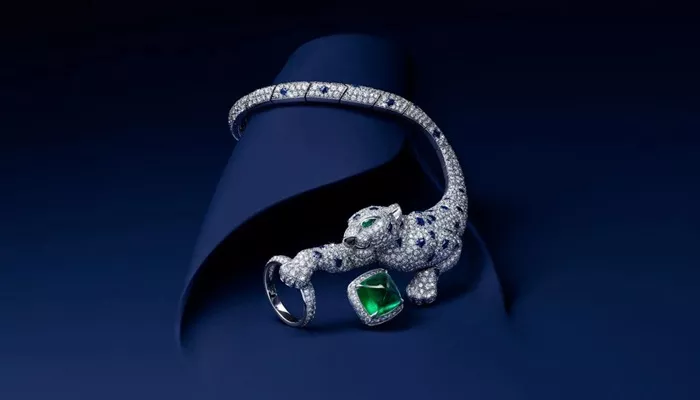Cartier’s animal-themed jewelry has shaped fashion and design for over a hundred years. From the original Panthère to the latest High Jewelry collection called Nature Sauvage, these creations blend style, symbolism, and craftsmanship.
Creating a Panthère is more than just showing an animal. Whether it appears moving on a wristwatch, poised on a brooch, or redesigned in many forms, the Panthère represents expert skill and creativity. Cartier does not only capture the shape of the feline but also its spirit. The pieces show articulated limbs, a sparkling diamond coat, and eyes full of life. Over the years, the Panthère has become a symbol of movement, precision, and power—wild but wearable. It is a shining example of Cartier’s mastery and one of the most famous designs in jewelry history.
Cartier first introduced the feline figures in 1949, thanks to Jeanne Toussaint, the creative director at the time. One early piece from that year shows a panther standing on a cabochon-cut sapphire weighing over 150 carats. The animal looks ready to leap forward. The piece is both jewelry and a bold statement. It stood out on the elegant Rue de la Paix, offering a fierce contrast to the simple and classic jewelry styles common then. People stopped to admire the daring piece in the shop window. It was bold, confident, and impossible to ignore.
Toussaint’s collection reflected a new postwar attitude. Before this, Cartier focused on Art Deco styles and designs inspired by 18th-century France and various global influences. But the turn to animal designs showed Cartier’s ongoing desire to surprise and innovate. What could be more captivating than a jewel-covered panther?
In 1940, Cartier made the Flamingo brooch. This colorful piece, decorated with rubies, emeralds, and sapphires, hinted at the house’s interest in animals. It brought a fresh sense of playfulness and bright colors that soon grew into a full collection of animal-inspired pieces. This brooch marked the start of the bold and lively style that defines Cartier’s animal jewelry.
Cartier’s big cat designs quickly became status symbols. They fascinated many glamorous women, including Hollywood stars and socialites. Famous clients often called the Rue de la Paix boutique late at night to order custom pieces. Tigers, snakes, and crocodiles were among the most popular animals. These designs often featured colorful enamel details chosen for special meanings. The mix of feline strength and mystery, covered in hundreds of gems, made these pieces irresistible.
Over time, Cartier’s animal jewelry changed and evolved. In 1983, the Panthère watch showed speed and grace through golden links. In 1991, a necklace captured the big cat’s spirit with a simple band of precious stones.
Today, Cartier has launched Nature Sauvage, a new High Jewelry collection. This collection explores animal energy through abstract shapes and creative designs. Instead of showing fur or feathers directly, these pieces suggest spirit and movement with shapes, patterns, and hints. For example, the Koaga necklace represents a zebra. It uses black onyx and diamonds to mimic its stripes. Sharp shapes suggest the ears, while a 6.25-carat pear-shaped rubellite hangs from the mouth like a prize.
Throughout the collection, animals appear in clever ways. Some are clear, like the Panthère des Glaces necklace. This piece shows an icy panther moving across a scene made of rock crystal, diamonds, and kite-shaped stones. Others are hidden. The Mochelys necklace-brooch has a turtle that only appears fully when worn as a brooch. The Alae necklace hides a beetle in the clasp, which first looks like a geometric shape but reveals its iridescent wings over time.
Reptiles in the collection are especially abstract. The Amphista necklace has two snakes curling around the neck. Their bodies are covered with diamond scales and decorated with nine Colombian emeralds and kite-shaped stones. The Tatsu necklace recalls a Chinese dragon. It is made from rubies and sculpted scales, with a head holding a pendant between sharp eyes and a stylized jaw. Even the Panthère has changed. The Panthère Jaillissante bracelet-ring combines a bracelet and ring. The panther has movable joints and graceful limbs that wrap around the wrist and hand. Its emerald eyes shine brightly.
In Nature Sauvage, Cartier’s animals do more than sparkle. They challenge how we see jewelry. These pieces are not exact pictures but creative illusions. They capture moments of change and transformation.
Related topics:
- Dravite Tourmaline: Earthy Beauty, Meaning & Jewelry Uses
- Lady Astor’s Rare Turquoise Tiara to Be Auctioned in London
- Borboleta Enters Luxury Jewelry Market with New Atelier Collection


